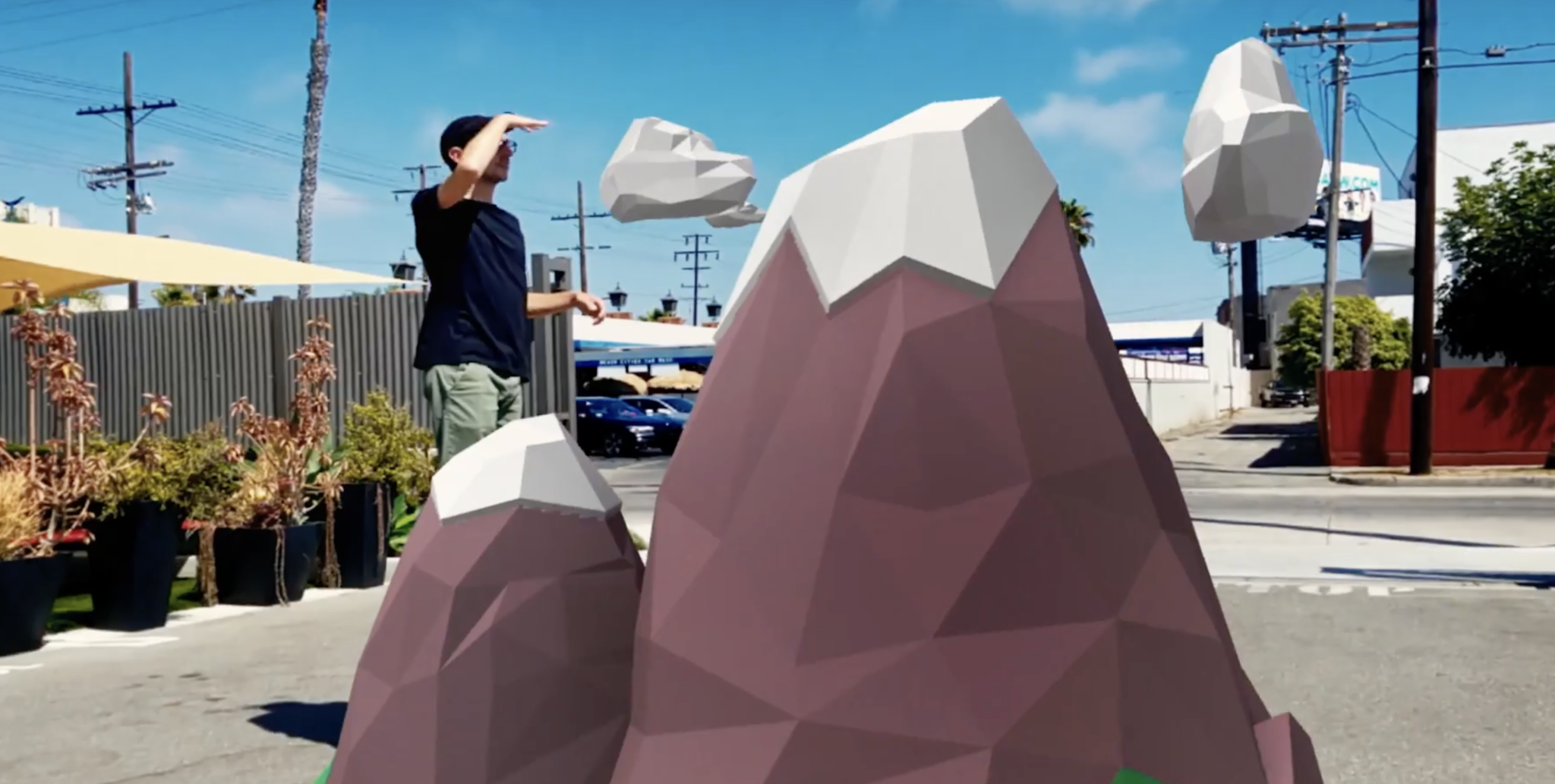 Augmented Reality (AR)[/caption] Augmented reality (AR) made a big impact in 2017. Since its debut, it seems everyone in tech has glommed onto the technology; from Apple to advertisers, anyone can create AR experiences. But what can we expect from AR in 2018? If you examine the landscape, there are some major players involved. Apple, Google, Facebook and Snapchat are the most notable. We tend to overlook Microsoft because of its confused messaging (first it was pushing AR, then ‘mixed reality,’ which the company claims is a combination of AR and virtual reality). Apple’s ARKit was easily the most anticipated AR launch of the year. With it, iOS developers everywhere were immediately able to weave augmented reality experiences into their own apps, which were immediately available to tens of millions of users. It was AR’s ‘hit the ground running’ moment. Subsequently, Google announced its own AR effort, the still-beta (or ‘early preview’ in Google’s language) ARCore. Like ARKit for iOS, ARCore allows developers for the Android platform to intersperse augmented experiences throughout their own apps and services. It’s still imperfect, and we’re not clear how many Android users will actually have access to AR features, but it’s a start. Facebook kept its AR initiatives close to home. It tethers augmented reality to Messenger, its widely used chat platform. More to the point, its “World Effects” AR feature is limited to photo and video enhancement. You can drop a cute 3D unicorn into a photo or video with some floating text. For Facebook, AR is more about image recognition than bespoke experiences. The same can be said for Snapchat, which uses AR with aplomb throughout its own service. The ‘dancing hotdog’ has spawned a platform named 'Lens Studio,' where anyone can build AR experiences for Snapchat. In fact, its initiative leans into its in-house ‘Lens’ platform that gave us the (infamous) dancing hot dog. It hopes everyone from students to brands will make their own AR characters, which naturally tie directly to Snapchat. Amazon just launched Sumerian, a platform for both AR and virtual reality (VR) experiences. It’s a bit odd, and feels like it's meant more for VR than AR, but it’s… something.
Augmented Reality (AR)[/caption] Augmented reality (AR) made a big impact in 2017. Since its debut, it seems everyone in tech has glommed onto the technology; from Apple to advertisers, anyone can create AR experiences. But what can we expect from AR in 2018? If you examine the landscape, there are some major players involved. Apple, Google, Facebook and Snapchat are the most notable. We tend to overlook Microsoft because of its confused messaging (first it was pushing AR, then ‘mixed reality,’ which the company claims is a combination of AR and virtual reality). Apple’s ARKit was easily the most anticipated AR launch of the year. With it, iOS developers everywhere were immediately able to weave augmented reality experiences into their own apps, which were immediately available to tens of millions of users. It was AR’s ‘hit the ground running’ moment. Subsequently, Google announced its own AR effort, the still-beta (or ‘early preview’ in Google’s language) ARCore. Like ARKit for iOS, ARCore allows developers for the Android platform to intersperse augmented experiences throughout their own apps and services. It’s still imperfect, and we’re not clear how many Android users will actually have access to AR features, but it’s a start. Facebook kept its AR initiatives close to home. It tethers augmented reality to Messenger, its widely used chat platform. More to the point, its “World Effects” AR feature is limited to photo and video enhancement. You can drop a cute 3D unicorn into a photo or video with some floating text. For Facebook, AR is more about image recognition than bespoke experiences. The same can be said for Snapchat, which uses AR with aplomb throughout its own service. The ‘dancing hotdog’ has spawned a platform named 'Lens Studio,' where anyone can build AR experiences for Snapchat. In fact, its initiative leans into its in-house ‘Lens’ platform that gave us the (infamous) dancing hot dog. It hopes everyone from students to brands will make their own AR characters, which naturally tie directly to Snapchat. Amazon just launched Sumerian, a platform for both AR and virtual reality (VR) experiences. It’s a bit odd, and feels like it's meant more for VR than AR, but it’s… something.
What Augmented Reality Will Mean to Devs in 2018
[caption id="attachment_143220" align="aligncenter" width="3090"]  Augmented Reality (AR)[/caption] Augmented reality (AR) made a big impact in 2017. Since its debut, it seems everyone in tech has glommed onto the technology; from Apple to advertisers, anyone can create AR experiences. But what can we expect from AR in 2018? If you examine the landscape, there are some major players involved. Apple, Google, Facebook and Snapchat are the most notable. We tend to overlook Microsoft because of its confused messaging (first it was pushing AR, then ‘mixed reality,’ which the company claims is a combination of AR and virtual reality). Apple’s ARKit was easily the most anticipated AR launch of the year. With it, iOS developers everywhere were immediately able to weave augmented reality experiences into their own apps, which were immediately available to tens of millions of users. It was AR’s ‘hit the ground running’ moment. Subsequently, Google announced its own AR effort, the still-beta (or ‘early preview’ in Google’s language) ARCore. Like ARKit for iOS, ARCore allows developers for the Android platform to intersperse augmented experiences throughout their own apps and services. It’s still imperfect, and we’re not clear how many Android users will actually have access to AR features, but it’s a start. Facebook kept its AR initiatives close to home. It tethers augmented reality to Messenger, its widely used chat platform. More to the point, its “World Effects” AR feature is limited to photo and video enhancement. You can drop a cute 3D unicorn into a photo or video with some floating text. For Facebook, AR is more about image recognition than bespoke experiences. The same can be said for Snapchat, which uses AR with aplomb throughout its own service. The ‘dancing hotdog’ has spawned a platform named 'Lens Studio,' where anyone can build AR experiences for Snapchat. In fact, its initiative leans into its in-house ‘Lens’ platform that gave us the (infamous) dancing hot dog. It hopes everyone from students to brands will make their own AR characters, which naturally tie directly to Snapchat. Amazon just launched Sumerian, a platform for both AR and virtual reality (VR) experiences. It’s a bit odd, and feels like it's meant more for VR than AR, but it’s… something.
Augmented Reality (AR)[/caption] Augmented reality (AR) made a big impact in 2017. Since its debut, it seems everyone in tech has glommed onto the technology; from Apple to advertisers, anyone can create AR experiences. But what can we expect from AR in 2018? If you examine the landscape, there are some major players involved. Apple, Google, Facebook and Snapchat are the most notable. We tend to overlook Microsoft because of its confused messaging (first it was pushing AR, then ‘mixed reality,’ which the company claims is a combination of AR and virtual reality). Apple’s ARKit was easily the most anticipated AR launch of the year. With it, iOS developers everywhere were immediately able to weave augmented reality experiences into their own apps, which were immediately available to tens of millions of users. It was AR’s ‘hit the ground running’ moment. Subsequently, Google announced its own AR effort, the still-beta (or ‘early preview’ in Google’s language) ARCore. Like ARKit for iOS, ARCore allows developers for the Android platform to intersperse augmented experiences throughout their own apps and services. It’s still imperfect, and we’re not clear how many Android users will actually have access to AR features, but it’s a start. Facebook kept its AR initiatives close to home. It tethers augmented reality to Messenger, its widely used chat platform. More to the point, its “World Effects” AR feature is limited to photo and video enhancement. You can drop a cute 3D unicorn into a photo or video with some floating text. For Facebook, AR is more about image recognition than bespoke experiences. The same can be said for Snapchat, which uses AR with aplomb throughout its own service. The ‘dancing hotdog’ has spawned a platform named 'Lens Studio,' where anyone can build AR experiences for Snapchat. In fact, its initiative leans into its in-house ‘Lens’ platform that gave us the (infamous) dancing hot dog. It hopes everyone from students to brands will make their own AR characters, which naturally tie directly to Snapchat. Amazon just launched Sumerian, a platform for both AR and virtual reality (VR) experiences. It’s a bit odd, and feels like it's meant more for VR than AR, but it’s… something.
 Augmented Reality (AR)[/caption] Augmented reality (AR) made a big impact in 2017. Since its debut, it seems everyone in tech has glommed onto the technology; from Apple to advertisers, anyone can create AR experiences. But what can we expect from AR in 2018? If you examine the landscape, there are some major players involved. Apple, Google, Facebook and Snapchat are the most notable. We tend to overlook Microsoft because of its confused messaging (first it was pushing AR, then ‘mixed reality,’ which the company claims is a combination of AR and virtual reality). Apple’s ARKit was easily the most anticipated AR launch of the year. With it, iOS developers everywhere were immediately able to weave augmented reality experiences into their own apps, which were immediately available to tens of millions of users. It was AR’s ‘hit the ground running’ moment. Subsequently, Google announced its own AR effort, the still-beta (or ‘early preview’ in Google’s language) ARCore. Like ARKit for iOS, ARCore allows developers for the Android platform to intersperse augmented experiences throughout their own apps and services. It’s still imperfect, and we’re not clear how many Android users will actually have access to AR features, but it’s a start. Facebook kept its AR initiatives close to home. It tethers augmented reality to Messenger, its widely used chat platform. More to the point, its “World Effects” AR feature is limited to photo and video enhancement. You can drop a cute 3D unicorn into a photo or video with some floating text. For Facebook, AR is more about image recognition than bespoke experiences. The same can be said for Snapchat, which uses AR with aplomb throughout its own service. The ‘dancing hotdog’ has spawned a platform named 'Lens Studio,' where anyone can build AR experiences for Snapchat. In fact, its initiative leans into its in-house ‘Lens’ platform that gave us the (infamous) dancing hot dog. It hopes everyone from students to brands will make their own AR characters, which naturally tie directly to Snapchat. Amazon just launched Sumerian, a platform for both AR and virtual reality (VR) experiences. It’s a bit odd, and feels like it's meant more for VR than AR, but it’s… something.
Augmented Reality (AR)[/caption] Augmented reality (AR) made a big impact in 2017. Since its debut, it seems everyone in tech has glommed onto the technology; from Apple to advertisers, anyone can create AR experiences. But what can we expect from AR in 2018? If you examine the landscape, there are some major players involved. Apple, Google, Facebook and Snapchat are the most notable. We tend to overlook Microsoft because of its confused messaging (first it was pushing AR, then ‘mixed reality,’ which the company claims is a combination of AR and virtual reality). Apple’s ARKit was easily the most anticipated AR launch of the year. With it, iOS developers everywhere were immediately able to weave augmented reality experiences into their own apps, which were immediately available to tens of millions of users. It was AR’s ‘hit the ground running’ moment. Subsequently, Google announced its own AR effort, the still-beta (or ‘early preview’ in Google’s language) ARCore. Like ARKit for iOS, ARCore allows developers for the Android platform to intersperse augmented experiences throughout their own apps and services. It’s still imperfect, and we’re not clear how many Android users will actually have access to AR features, but it’s a start. Facebook kept its AR initiatives close to home. It tethers augmented reality to Messenger, its widely used chat platform. More to the point, its “World Effects” AR feature is limited to photo and video enhancement. You can drop a cute 3D unicorn into a photo or video with some floating text. For Facebook, AR is more about image recognition than bespoke experiences. The same can be said for Snapchat, which uses AR with aplomb throughout its own service. The ‘dancing hotdog’ has spawned a platform named 'Lens Studio,' where anyone can build AR experiences for Snapchat. In fact, its initiative leans into its in-house ‘Lens’ platform that gave us the (infamous) dancing hot dog. It hopes everyone from students to brands will make their own AR characters, which naturally tie directly to Snapchat. Amazon just launched Sumerian, a platform for both AR and virtual reality (VR) experiences. It’s a bit odd, and feels like it's meant more for VR than AR, but it’s… something.



